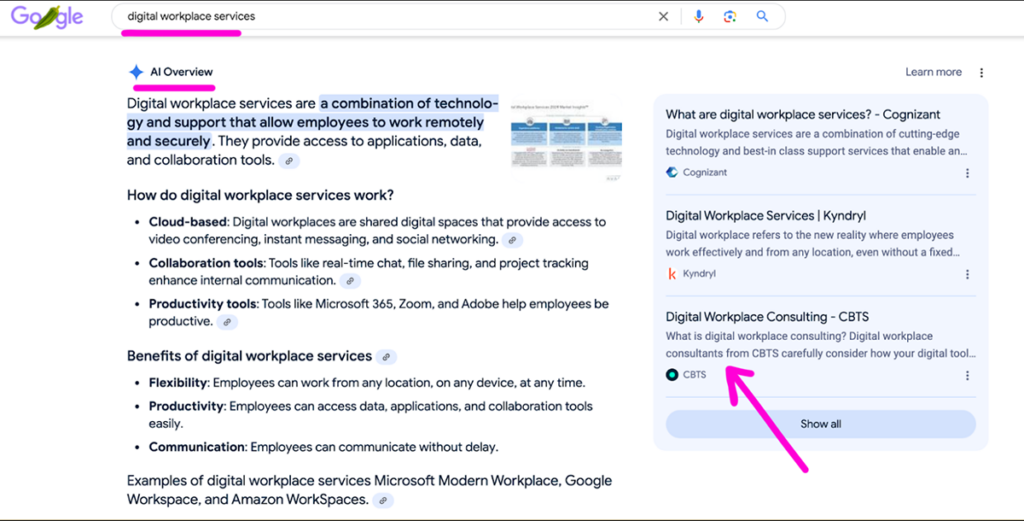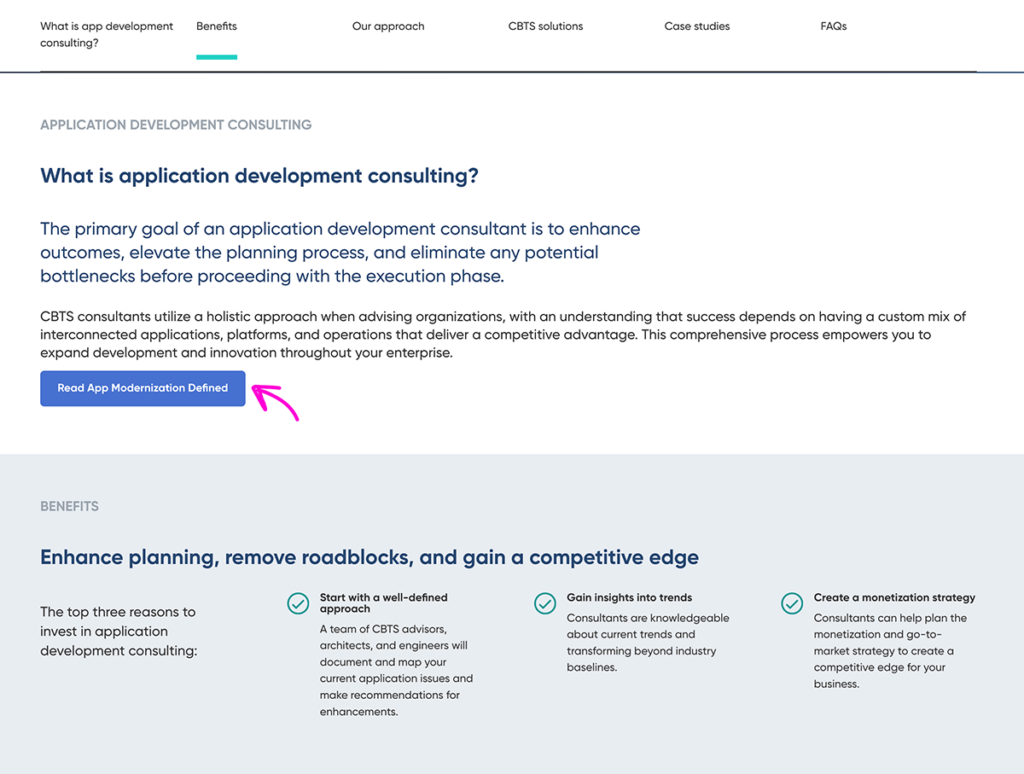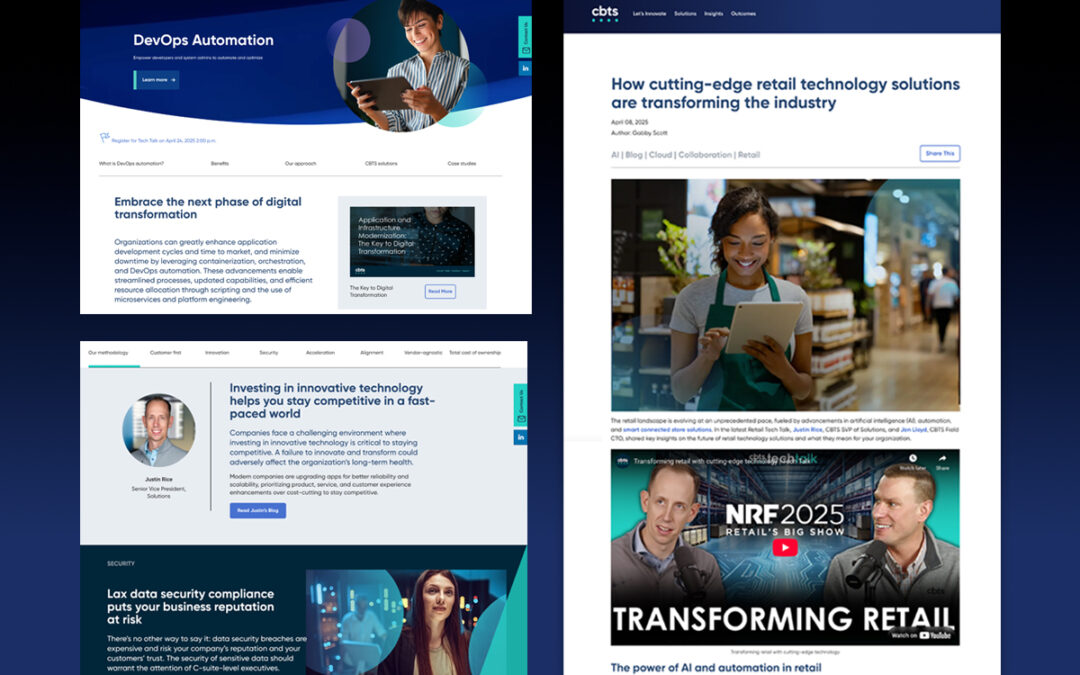Our client [CBTS] is an enterprise technology solution provider that serves a diverse range of over 3,000 global clients. Over the past year, the company took on a significant challenge: it wanted to improve its organic keyword rankings (via SEO) and increase its visibility in search engine results pages (SERPs). To achieve this, they made a bold decision to overhaul the entire website.
With more than 130 pages planned for the updated website, this was no small feat. The project was complex, requiring the careful balance of multiple elements, including strategy, user experience, SEO, and branding. The existing website was a third of the size of the projected final product, necessitating expansion and new keyword optimization research.
The primary goals for this project were to strengthen content authority, enhance brand visibility, and secure featured SERP positions on Google. Our team was tasked with writing the content for the entire site, with a strong focus on optimizing SEO keywords for search engines to better meet these objectives.
Strategy development
We guided our client through a series of steps to ensure the smooth rollout of the project.
Keyword research and selection
Before the writing began, we worked closely with the client on keyword choices. We started this process after mapping out the navigation but before any writing. We created a cohesive SEO strategy by identifying high-value keywords based on search intent and competition metrics, such as keyword difficulty (a measure of the competitiveness of a given keyword) and search volume.
In the technology sector, buzzwords and acronyms (like zero trust and SASE) evolve rapidly as new tech emerges and older tech fades away. These industry buzzwords do not always align with popular keywords or ones that will rank well. (Note that these terms are often excellent fodder for creating eBook content and other collateral that is not dependent on SEO rankings.)
Since the client was focused on improving search KPIs and wanted ways to track results, they were invested in the SEO and SERP results and had final approval over the keywords we selected.
Also read: Blue Star wins seven MarCom and GDUSA Awards in 2024
Our content optimization approach
We needed to expand and enhance the existing website content while generating brand-new pages, all of which had to be aligned with Google’s ranking factors. To make our content easier to rank in SERPs, we developed content with frequently asked questions in mind for nearly every page.
SERP is an integral part of keyword strategy and SEO. SERP or Search Engine Results Page—is what you see after you search for something on Google. Think of it like a leaderboard for websites. Google ranks pages based on how relevant and helpful they are to your search.

Caption: A screengrab of one of the SERP ranking CBTS keywords.
SERP consists of:
- Organic Results: Websites that Google thinks are the best match for your search (this is what SEO helps improve)
- Featured Snippets: Quick answers at the top, like definitions or step-by-step guides
- People Also Ask: Suggested related questions
Note that SERP is starting to change with the advent of AI-powered search. Many of the principles are the same, such as writing high-quality content that answers user questions, but the strategy is a little different (and evolving) for AI SERP. (For more information, check back soon to read our upcoming guide to ranking in AI search.)

Caption: An example of an AI SERP. CBTS is ranked third for this particular keyword.
To increase our chances of ranking on the new content, we focused on user queries and following Google’s Keyword Practices:
- Title – Include your primary keyword naturally.
- Introduction – Use the keyword within the first 100 words to establish relevance.
- Headings (H2, H3, H4) – Use the keyword once in a heading. It helps structure content and boosts SEO.
- Body text – Use keywords naturally throughout the post, approximately 5 to 10 times. Don’t overdo it—avoid keyword stuffing, which can get you penalized by Google.
- URL – Keep it short and include the primary keyword.
- Meta description – A short, summary that helps with click-through rates and uses the keyword once.
- Use one unique keyword per page to keep from cannibalizing content strategies. (In other words, don’t repeat the same keyword twice on the same website.)
Search intent is a big part of keyword strategy and content development. Once viewers hit a page, they need to know quickly that the content aligns with their needs.
We use a storytelling approach that helps us align with Google’s E-E-A-T framework (Experience, Expertise, Authoritativeness, and Trustworthiness):
- Immediately recognize and justify the client’s pain points and empathize with the problem.
- Simply explain how the problem can be resolved (by our client).
- Mention the benefits of the solution.
- Explain the client’s approach and highlight their differentiator from competitors.
All of these best practices help with SEO rankings and SERP results, as well as humanizing the brand with the subconscious language we all speak: story.
Also read: Build your blog content strategy around quantity, quality, and cadence
Technical and on-page SEO enhancements
Improving meta descriptions, title tags, and header structures: We used Yoast to ensure our content was well-optimized before publishing. Yoast is a popular SEO plugin for WordPress that helps optimize website content for search engines. It provides real-time suggestions to improve readability, keyword usage, and technical SEO. We ensured all the imagery used on each page was tagged with the keyword.
Implementing internal linking strategies: This was a massive challenge, as we worked with entirely new navigation, services, and content. Knowing what link to provide was difficult when everything was being built from scratch.
So, we asked the client’s Subject Matter Experts to provide a set number of blogs, eBooks, and videos correlated to the new pages. Then, we specifically created sections to highlight the content. (In a few cases, we created new blog posts or eBooks from scratch to ensure a solid content journey. Fortunately, we’ve been working with the client for years and are well-versed in creating content for them.)
We included this related collateral in the site build to generate better internal SEO and drive organic results.

Caption: An example of internal content linking strategy from the new website.
Execution and implementation
Next came the step-by-step process of rolling out optimized content. Every item used in tracking and content development included the keyword. This way, everyone involved was aware of the keywords from start to finish. That included those who approved navigation, our project managers, our writers, our editors, everyone across the client, the content entry person, and developers.
Blue Star tracked the content process through shared templates we created in Google Docs and project management cards in Trello. Each content page involved four people on our side and at least four on the client’s side. Clear communication was critical to keep everything on track.
The finished web page totaled a word count that rivals “The Grapes of Wrath” (i.e., 464 pages of prose, or roughly 110,000 words). We tripled the word count from the original pages. Each of the 130 updated pages underwent multiple rounds of edits for both text and imagery. After polishing them to a shine, we submitted each page for approval by primary stakeholders at CBTS.
Over the years of working with the client, we’ve kept a document listing each keyword for blog development. Before this job, we quickly swept the old site to review the entire list again. We continue this practice to prevent duplicate content (which can drastically hurt ranking). We track all our keywords in the Semrush Project tracker to monitor performance and how we compare to our competitors targeting the same keywords.
Results and Impact
Keyword performance growth:

- January 2024: 180 keywords in the top 10, 47 in SERP
- January 2025: 232 keywords in the top 10, 158 in SERP
What this means:
- A 24% increase in top 10 rankings
- A 219% increase in SERP placements (earned top placements based on Google’s algorithm)
These metrics demonstrate that Google now considers the client’s content a top authoritative source.
“We couldn’t be more thrilled with the results of our collaboration with Blue Star. The team’s exceptional approach to teamwork made a significant difference in our website overhaul. Not only did they enhance the visual impact of our site, but their targeted keyword strategy has led to substantial improvements in our search rankings. We’ve seen a noticeable increase in organic traffic, and our visibility in search engine results has never been better. This project has truly transformed how we connect with our clients online.”
– Eric Miller, Vice President of Marketing at CBTS
Key takeaways and learnings
The entire website took just over a year and a half to complete (much of that time was web development, which Blue Star did not do for this project). Here are a few takeaways we gleaned from our time on the project:
- Content refinement is essential for relevance in the digital landscape. Regular updates ensure accuracy and alignment with trends and boost user engagement by enhancing existing content with new insights and multimedia.
- Strategic keyword selection is critical for effective SEO and SERP visibility.
- It’s vital to clearly communicate your keyword strategy with all stakeholders to avoid confusion and penalization from repeat keywords or content.
- High and numerous SERP rankings build credibility and trust and increase brand visibility, awareness, and authority.
- Technical SEO elements, user experience, and quality content align with broader marketing goals for better audience engagement and awareness.
SEO is a long-term investment that reaps huge rewards as a part of a larger content marketing strategy.
Do you need help planning a website refresh or gaining traction with your content or SEO strategy? Contact us to learn more.

